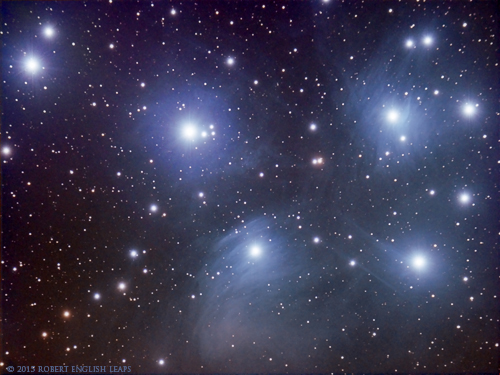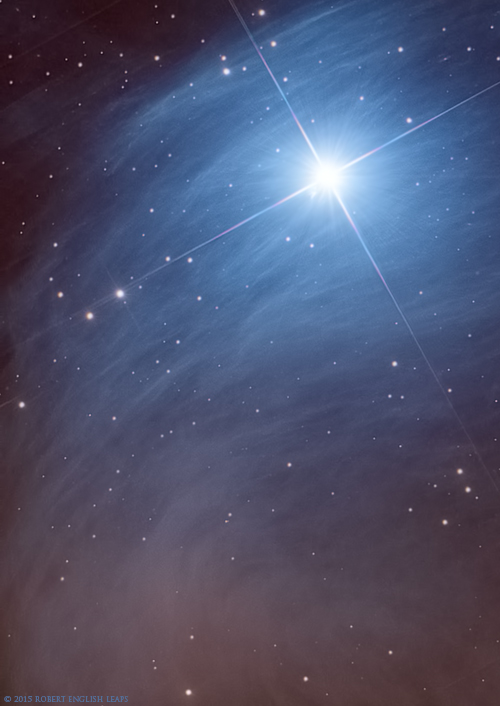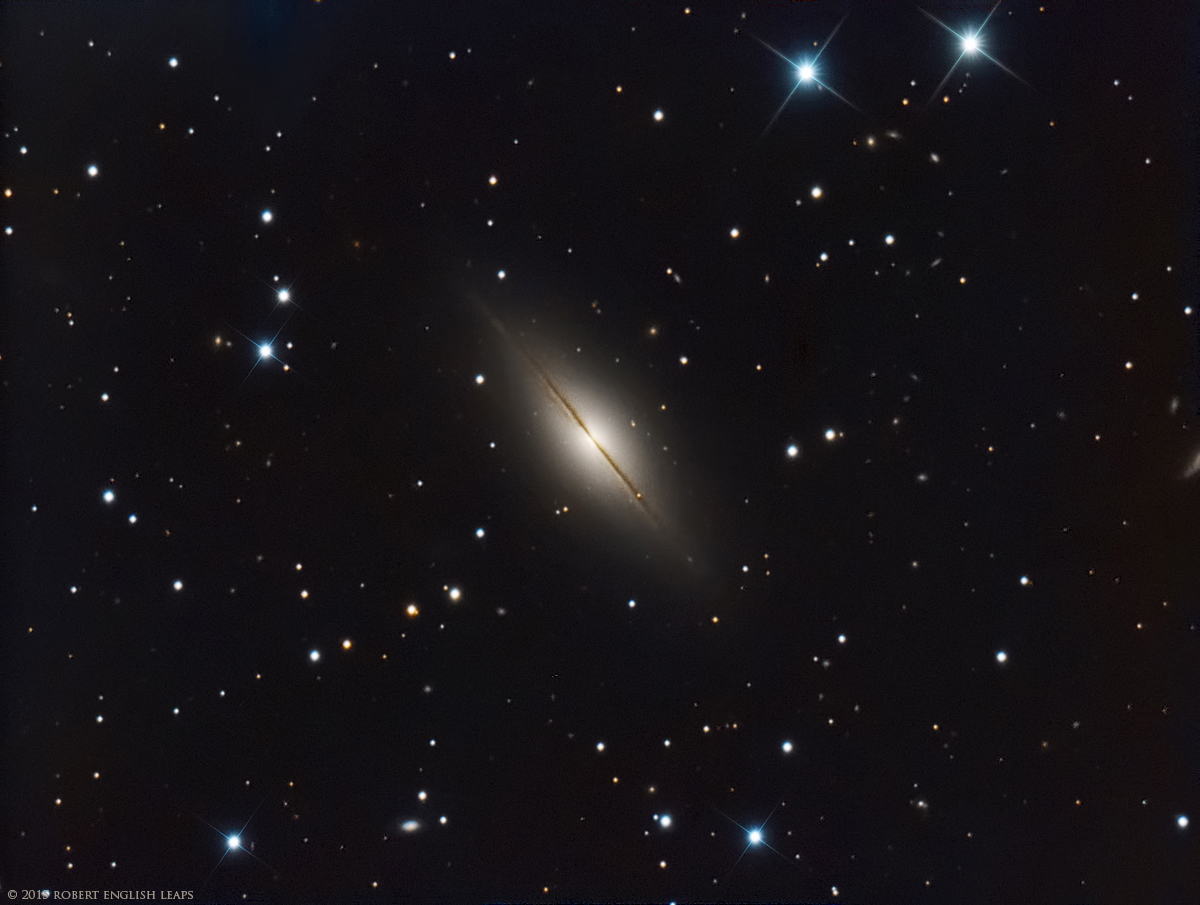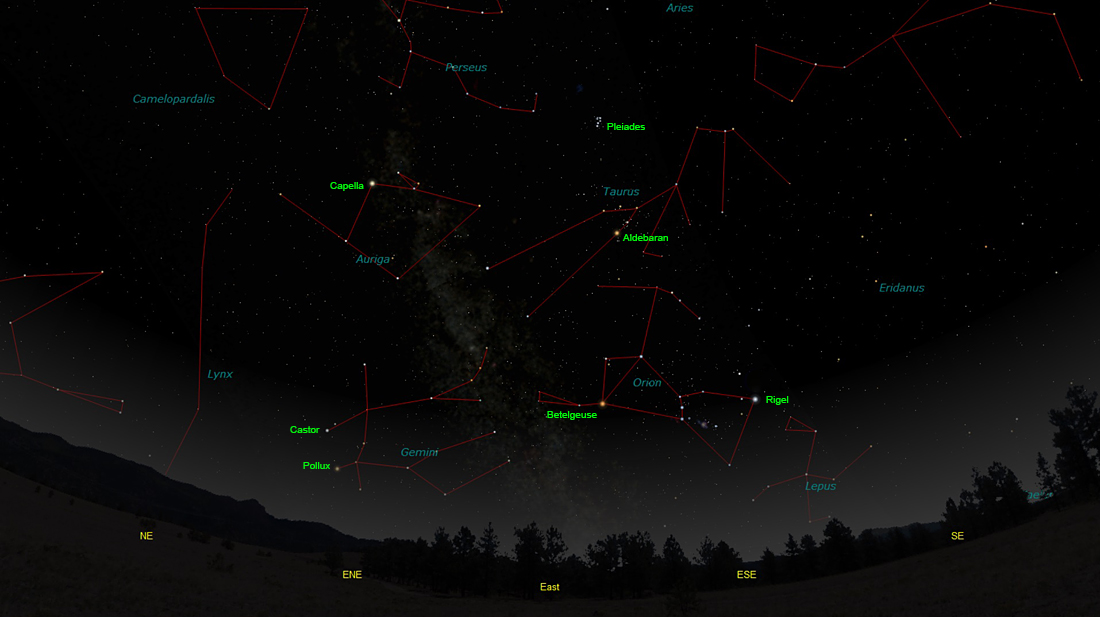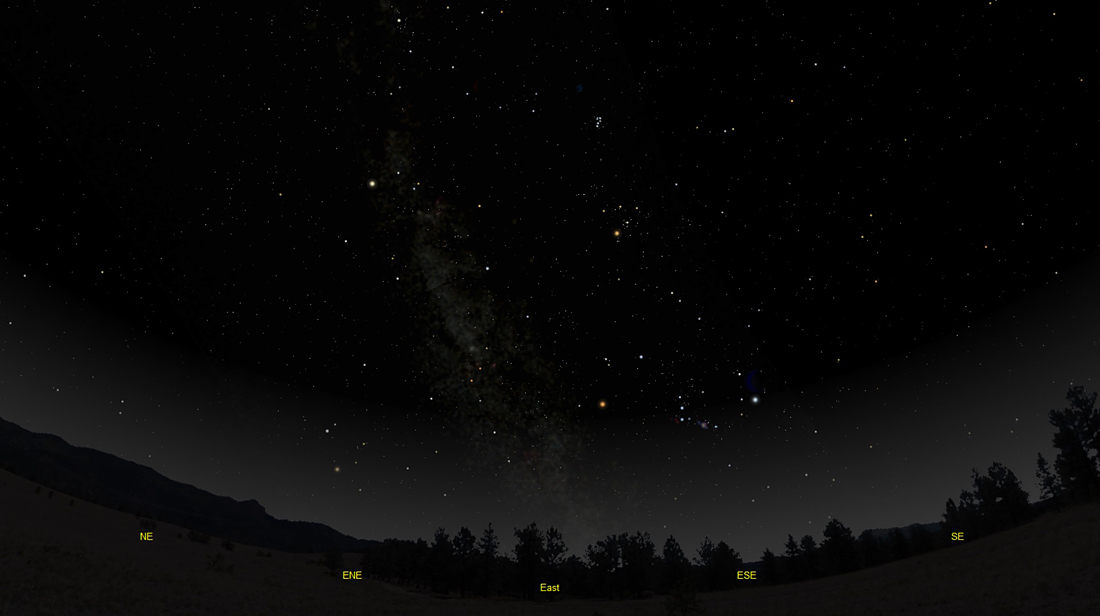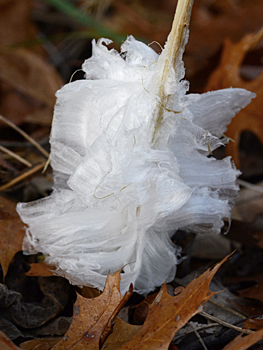The purpose of this feature is to give scout leaders, educators and naturalists an idea of some of the natural events coming up each month. We will try to cover a variety of natural events ranging from sky events to calling periods of amphibians, bird and mammal watching tips, prominent wildflowers and anything else that comes to mind. We will also note prominent constellations appearing over the eastern horizon at mid-evening each month for our area for those who would like to learn the constellations. If you have suggestions for other types of natural information you would like to see added to this calendar, let us know! Note: You can click on the hyperlinks to learn more about some of the featured items. To return to the Calendar, hit the "back" button on your browser, NOT the "back" button on the web page. All charts are available in a "printer friendly" mode, with black stars on a white background. Left clicking on each chart will take you to a printable black and white image. Please note that images on these pages are meant to be displayed at 100%. If your browser zooms into a higher magnification than that, the images may lose quality. Though we link book references to nationwide sources, we encourage you to support your local book store whenever possible.
Notes and Images From October 2015 Last month we spent a good bit of time automating the observatory. Though the 12.5 inch reflector has been fully autonomous for a while, there were several features of the observatory that had to be tested before the entire observatory could be remotely operated. This included things like opening and closing the roof and sealing the ends of the telescope tube after an observing run. While we were testing we were fortunate to have a few clear nights to let the scope gather some starlight.
The Pleiades have fascinated sky watchers since antiquity. This bright star cluster, wreathed in faint reflection nebulosity, is beautiful regardless of how you observe it. We love to watch it rise above the tree line at the farm. My favorite view of the cluster is through binoculars. On very clear fall nights, I've seen the nebulosity around Merope (bottom left star) with my 80mm Televue refractor. The view of the cluster at right was taken back in 2009 with that telescope. Although most of the nebulosity in the Pleiades is reflection nebulosity, there is a little emission nebulosity below Merope, which adds a reddish tint. The Pleiades are not believed to have formed in the nebulosity, but are thought to be moving as a group through this dusty region of space. To me the nebulosity looks like cirrus clouds passing high overhead. The image at bottom right was taken with our 12.5 inch Newtonian reflector, and gives a much larger image scale. The orientation on both images is the same. Merope is the very bright star at upper right. At about the 8:00 position, very close to the star, you can see what first looks like an internal reflection - a very bright spike of light. This is Barnard's Merope Nebula (IC349), discovered visually by Edward Emerson Barnard in 1890. A Hubble image of the nebula is here. Barnard's Merope Nebula is not to be confused with the larger, red-tinged Merope Nebula (NGC 1435) at the bottom of the image. The Merope nebula was discovered visually by Tempel in 1859. He compared its appearance in the eyepiece to breath on a mirror. The midnight culmination of the Pleiades, that is, when the cluster is highest in the sky at midnight, has been an important date in many cultures. In the middle ages, it marked the All Hallows' Eve or Halloween. The midnight culmination of the Pleiades no longer coincides with Halloween, occurring around November 20th. This is due to a number of factors, including the implementation of the Gregorian calendar in 1582. In order for the calendar to accurately reflect the seasons, 10 days were dropped from the month of October at that time.
The skies cleared again on October 21st, and this time we chose an edge-on galaxy in Pegasus, NGC 7814. The galaxy is just about perfectly edge-on, and the silhouetted dust clouds are very thin. According to Stephan James O'Meara, "A photograph of NGC 7814, taken in 1899 by James Keller at Lick Observatory, inspired the famous astronomer-artist Lucien Rudaux (1874-1947) to write, 'It bears a curious resemblance to an electric arc between two pointed electrodes.'" You can see this resemblance in the center part of image below. Finding the bright core of the galaxy is not too hard in a medium-sized telescope, though the dust lane is not as obvious as it is in the image below. Like other edge-on galaxies, it looks a little like a flying saucer wheeling its way through the star field.
NGC 7814 is tucked just inside the southeast corner of the 'square of Pegasus." That's the corner that's lowest to the horizon as the square rises. Distance estimates range between 40 and 50 million light-years.
Sky Events for November 2015: The Leonid Meteor Shower peaks in the morning hours of November 17th. Evening Sky: Saturn can be spotted very low in the southwest at dusk early in the month. Look for it about 10 degrees above the southwest horizon 30 minutes after sunset. Binoculars will help pick it out of the twilight glow. By mid-month it will be too close to the Sun to observe. Morning Sky: Jupiter rises about 1:55am and is now the uppermost of the planets in the eastern pre-dawn sky. It is in Leo. Venus rises about 2:25am in Leo at the beginning of the month and is dazzling in the eastern sky before sunrise. Mars is also in Leo as the month begins, and rises right beside Venus. Mars is still quite small in the eyepiece, less than 5 arc-seconds in diameter. The red color is easily visible in binoculars. All times noted in the Sky Events are for Franklin, Tennessee and are in Central Standard Time. These times should be pretty close anywhere in the mid-state area.
Constellations: The views below show the sky looking east at 9:30pm CST on November 15th. The first view shows the sky with the constellations outlined and names depicted. Star and planet names are in green. Constellation names are in blue. The second view shows the same scene without labels. Auriga, the Charioteer, with its bright star Capella is prominent in the northeast. Look for the bright stars Castor and Pollux as the constellation Gemini, The Twins, clears the horizon. In the southeast, mighty Orion clears the horizon with its bright stars Betelgeuse and Rigel. Note the difference in color between the two stars. Betelgeuse is a red giant and looks orange. Rigel is very hot supergiant and looks bluish. Looking at the center of the three "sword" stars with binoculars, you can see M42, the Orion Nebula. Just poking its head above the horizon is Lepus, The Hare.On Learning the Constellations: We advise learning a few constellations each month, and then following them through the seasons. Once you associate a particular constellation coming over the eastern horizon at a certain time of year, you may start thinking about it like an old friend, looking forward to its arrival each season. The stars in the evening scene above, for instance, will always be in the same place relative to the horizon at the same time and date each November. Of course, the planets do move slowly through the constellations, but with practice you will learn to identify them from their appearance. In particular, learn the brightest stars for they will guide you to the fainter stars. Once you can locate the more prominent constellations, you can "branch out" to other constellations around them. It may take you a little while to get a sense of scale, to translate what you see on the computer screen or what you see on the page of a book to what you see in the sky. Look for patterns, like the stars that make up Orion.The earth's rotation causes the constellations to
appear to move across the sky just as the Sun and the Moon appear to do.
If you go outside earlier than the time shown on the charts, the constellations
will be closer to the eastern horizon. If you observe later, they will
have climbed higher. As each season progresses, the earth's motion around the Sun causes the constellations to appear a little farther towards the west each night for any given time of night. If you want to see where the constellations in the above figures will be on December 15th at 9:30pm CST, you can stay up till 11:30pm CST on November 15th and get a preview. The westward motion of the constellations is equivalent to two hours per month. Recommended: Sky & Telescope's Pocket Star Atlas is beautiful, compact star atlas. A good book to learn the constellations is Patterns in the Sky, by Hewitt-White. You may also want to check out at H. A. Rey's classic, The Stars, A New Way to See Them. For skywatching tips, an inexpensive good guide is Secrets of Stargazing, by Becky Ramotowski. A good general reference book on astronomy is the Peterson
Field Guide,
A Field Guide to the Stars and Planets, by Pasachoff. The book retails for around $14.00. Starry Night has several software programs for learning the night sky. Visit the Starry Night web site at www.starrynight.com for details. The Virtual Moon Atlas is a terrific way to learn the surface features of the Moon. And it's free software. You can download the Virtual Moon Atlas here. Cartes du Ciel (described in the monthly notes above) is a great program for finding your way around the sky. It is also free, and can be downloaded here. Apps: We really love the Sky Safari Pro application described here. For upcoming events, the Sky Week application is quite nice. Both apps are available for both I-phone and Android operating systems. The newest version, Sky Safari 4, is available here.
Amphibians:
We think of November as the quietest time of year for Tennessee frogs and toads. However, some song can still occasionally be heard. Listen for Spring Peepers, Upland Chorus Frogs and Southern Leopard Frogs. Checking around ponds at night with a flashlight held next to your temple will often show the eye shine of Southern Leopard Frogs, Green Frogs and Bullfrogs. As in October, you can locate many of the frogs and toads that have been calling more frequently earlier in the year by driving the back roads slowly on rainy nights. This is a two person job. One person watches the road for amphibians and one person looks out for other vehicles. Recommended: The Frogs and Toads of North America, Lang Elliott, Houghton Mifflin Co.
Frost Flowers:
As the first few hard frosts of the coming winter hit us, we always enjoy seeing Frostweed ice sculptures early each morning. They are another sign of the season. Frostweed, also called White Crownbeard, is a common wildflower in Tennessee that frequents roadsides, streamsides and weedy fields. Its white flowers bloom in August through October. When freezing temperatures arrive, the lower stem splits and water is forced out through the fissures as it freezes and expands, creating beautiful and unique "frost flowers" just above the ground. Part of the beauty of these creations is their transient nature. Often they disappear shortly after the first rays of the sun reach them. For or a brief time, though, these small marvels add a touch of fantasy to the brisk fall mornings.
Archives (Remember to use the back button on your browser, NOT the back button on the web page!) Natural Calendar November 2014 Natural Calendar September 2014 Natural Calendar February 2014 Natural Calendar January 2014 Natural Calendar December 2013 Natural Calendar September 2013 Natural Calendar February 2013 Natural Calendar January 2013 Natural Calendar December 2012 Natural Calendar November 2012 Natural Calendar September 2012 Natural Calendar February 2012 Natural Calendar December 2011 Natural Calendar November 2011 Natural Calendar September 2011 Natural Calendar December 2010 Natural Calendar November 2010 Natural Calendar September 2010 Natural Calendar February 2010 Natural Calendar December 2009 Natural Calendar November 2009 Natural Calendar September 2009 Natural Calendar February 2009 Natural Calendar December 2008 Natural Calendar November 2008 Natural Calendar September 2008 Natural Calendar February 2008 Natural Calendar December 2007 Natural Calendar November 2007 Natural Calendar September 2007 Natural Calendar February 2007 Natural Calendar December 2006 Natural Calendar November 2006 Natural Calendar September 2006 Natural Calendar February 2006 Natural Calendar December 2005Nature Notes Archives: Nature Notes was a page we published in 2001 and 2002 containing our observations about everything from the northern lights display of November 2001 to frog and salamander egg masses. Night scenes prepared with The Sky Professional from Software Bisque All images and recordings © 2015 Leaps
| |
